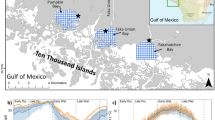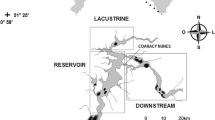Abstract
The present study characterizes the fish assemblage in the surf zone of Cassino Beach, Rio Grande, Brazil, and analyzes temporal fluctuations in richness and abundance of these species in medium (months) and long terms (years), associating them also with abiotic covariates. Data were collected monthly between 1996 and 2012 at two locations. Bayesian generalized additive models (GAMs) were used as statistical tool, placing this study among few that have used Bayesian GAMs in Ecology. Our results show a decrease in both species richness and abundance of the most representative species, over the last 16 years, but no significant distinction between locations. Water temperature and salinity along with seasonality were the statistically most influential explanatory covariates to describe fluctuations in richness and abundance. Higher discharge rates of the three main rivers that flow into Patos Lagoon (Jacuí, Taquari, Camaquã) were associated with increased richness and abundance of some species in the assemblage. Hence, our findings show that medium- and long-term fluctuations in richness and species abundance are controlled by abiotic factors related to seasonal cycles (temperature) and productivity of the ecosystem. Long-term changes seem to be also related to man-induced factors and climate change; but further research is needed.





Similar content being viewed by others
References
Able KW, Grothues TM, Rowe PM, Wuenschel MJ, Vasslides JM (2011) Near-surface larval and juvenile fish in coastal habitats: comparisons between the inner shelf and an estuary in the New York Bight during summer and fall. Estuar Coasts 34:726–738
Ayvazian SG, Hyndes GA (1995) Surf-zone fish assemblages in south-western Australia: do adjacent nearshore habitats and the warm Leeuwin Current influence the characteristics of the fish fauna? Mar Biol 122:527–536
Belitz C, Brezger A, Kneib T, Lang S (2009) BayesX—Bayesian inference in structured additive regression models. http://www.stat.uni-muenchen.de/~bayesx. Accessed March 2012
Bell KNI, Cowley PD, Whitfield AK (2001) Seasonality in frequency of marine access to an intermittently open estuary: implications for recruitment strategies. Estuar Coast Shelf Sci 52:327–337
Brown AC, McLachlan A (1990) Ecology of Sandy shores. Elsevier, New York
Brown RL, Jacobs LA, Peet RK (2007) Species richness: small scale, encyclopedia of life sciences, vol 26. Wiley, New Jersey
Caddy JF, Sharp GD (1986) An ecological framework for marine fishery investigations. FAO fisheries technical paper, Rome
Calliari LJ, Speranski N, Torronteguy M, Oliveira MB (2001) The mud banks of Cassino Beach, southern Brazil: characteristics, processes and effects. J Coast Res 34:318–325
Calliari LJ, Holland KT, Pereira PS, Guedes RMC, Santo RE (2007) the influence of mud on the Inner Shelf, Shoreface, Beach and Surf Zone Morphodynamics—Cassino, Southern Brazil. Coast Sedim 07:1–11
Calliari LJ, Winterwerp JC, Fernandes E, Cuchiara D, Vinzon SB, Sperle M, Holland KT (2009) Fine grain sediment transport and deposition in the Patos Lagoon—Cassino Beach sedimentary system. Cont Shelf Res 29:515–529
Castillo-Rivera M, Zárate-Hernandez R, Ortiz-Burgos S, Zavala-Hurtado J (2010) Diel and seasonal variability in the fish community structure of a mud-bottom estuarine habitat in the Gulf of Mexico. Mar Ecol 31:633–642
Chatfield C, Collins AJ (1980) Introduction to multivariate analysis. CRC Press, London
Dalla Rosa L, Ford JKB, Trites AW (2012) Distribution and relative abundance of humpback whales in relation to environmental variables in coastal British Columbia and adjacent waters. Cont Shelf Res 36:89–104
Denison DGT, Mallick BK, Smith AFM (1998) Automatic Bayesian curve fitting. J R Stat Soc B 60:333–350
Edwards AWF (1972) Likelihood. Cambridge Academic Press, Cambridge
Eilers P, Marx B (1996) Flexible smoothing using B-splines and penalizes likelihood. Stat Sci 11:89–121
Fahrmeir L, Lang S (2001) Bayesian inference for generalized additive mixed models based on Markov random field prioris. Appl Stat 50:201–220
Faraway JJ (2006) Extending the linear model with R: generalized linear, mixed effects and nonparametric regression models. CRC Press, Boca Raton
Fischer LG, Pereira LED, Vieira JP (2011) Peixes estuarinos e costeiros. Conscientia, Rio Grande
Garcia AM, Vieira JP (2001) O aumento da diversidade de peixes no estuário da Lagoa dos Patos durante o episódio El Niño 1997–1998. Atlantica 23:85–96
Garcia AM, Vieira JP, Winemiller KO, Grimm AM (2004) Comparison of 1982–1983 and 1997–1998 El Niño effects on the shallow-water fish assemblage of the Patos Lagoon estuary (Brazil). Estuar Coasts 27:905–914
Gelman A, Carlin JB, Stern HS, Dunson DB, Vehtari A, Rubin D (2013) Bayesian data analysis. CRC Press, Boca Raton
Gibson RN, Robb L, Burrows MT, Ansell AD (1996) Tidal, diel and longer term changes in the distribution of fishes on a Scottish sandy beach. Mar Ecol Prog Ser 130:1–17
Gomes MP, Cunha MS, Zalmon IR (2003) Spatial and Temporal Variations of Diurnal Ichthyofauna on Surf-Zone of São Francisco do Itabapoana Beaches, Rio de Janeiro State, Brazil. Braz Arch Biol Technol 46:653–664
Gotelli NJ, Colwell RK (2001) Quantifying biodiversity: procedures and pitfalls in the measurement and comparison of species richness. Ecol Lett 4:379–391
Guisan A, Thuiller W (2005) Predicting species distribution: offering more than simple habitat models. Ecol Lett 8:993–1009
Guisan A, Zimmermann NE (2000) Predictive habitat distribution models in ecology. Ecol Model 135:147–186
Hammer Ø, Harper DAT, Ryan PD (2001) PAST: paleontological statistics software package for education and data analysis. http://folk.uio.no/ohammer/past/. Accessed March 2012
Hardle W, Simar L (2007) Applied multivariate statistical analysis. Springer, Berlin
Hastie TG, Tibshirani RJ (1990) Generalized additive models. CRC Press, Boca Raton
Haynes PS, Brophy D, McGrath D, O’Callaghan R, Comerford S, Casburn P (2010) Annual and spatial variation in the abundance length and condition of juvenile turbot (Psetta maxima L.) on nursery grounds on the west coast of Ireland: 2000–2007. J Sea Res 64:494–504
Hubálek Z (2000) Measures of species diversity in ecology: an evaluation. Folia Zool 49:241–260
Kéry M (2010) Introduction to WinBUGS for ecologists. Elsevier, London
Kinas PG, Andrade HA (2010) Introdução à Análise Bayesiana (com R). Mais Que Nada, Porto Alegre
Knox GA (2001) The Ecology of Sea Shores. CRC Press, Boca Raton
Krebs CJ (1989) Ecological methodology. Harper and Row, New York
Kristiansen T, Drinkwater KF, Lough RG, Sundby S (2011) Recruitment variability in North Atlantic cod and match-mismatch dynamics. PLoS One 6:e17456
Lang S, Brezger A (2004) Bayesian P-splines. J Comput Gr Stat 13:183–212
Lima MSP, Vieira JP (2009) Variação espaço-temporal da ictiofauna da zona de arrebentação da Praia do Cassino, Rio Grande do Sul, Brasil. Zoologia 26:499–510
Lin X, Zhang D (1999) Inference in generalized additive mixed models by using smoothing splines. J R Stat Soc B 61:381–400
Lindley D (2000) The philosophy of statistics. Statistician 49:233–337
Magurran AE (2004) Measuring biological diversity. Blackwell, Malden
Margalef DR (1958) Information theory in ecology. Gen Syst 3:36–71
Martino EJ, Houde ED (2010) Recruitment of striped bass in Chesapeake Bay: spatial and temporal environmental variability and availability of zooplankton prey. Mar Ecol Prog Ser 409:213–228
McCarthy MA (2007) Bayesian methods for ecology. Cambridge University Press, New York
McIntosh RP (1967) An index of diversity and the relation of certain concepts to diversity. Ecology 48:392–404
McLachlan A, Brown AC (2006) The ecology of sandy shores. Academic Press, Burlington
Menhinick EF (1964) A comparison of some species-individuals diversity indices applied to samples of field insects. Ecology 45:859–861
Miranda LB, Castro BM, Kjerfve B (2002) Princípios de Oceanografia Física de Estuários. Editora Universidade de São Paulo, São Paulo
Modde T, Ross ST (1981) Seasonality of fishes occupying a surf zone habitat in the Northern Gulf of Mexico. Fish Bull 78:911–922
Mont’Alverne R, Moraes LE, Rodrigues FL, Vieira JP (2012) Do mud deposition events on sandy beaches affect surf zone ichthyofauna? A southern Brazilian case study. Estuar Coast Shelf Sci 102–103:116–125
Monteiro-Neto C, Cunha LPR, Musick JA (2003) Community structure of surf-zone fishes at Cassino Beach, Rio Grande do Sul, Brazil. J Coast Res 35:492–501
Moraes LE, Paes E, Garcia A, Moller JRO, Vieira J (2012) Delayed response of fish abundance to environmental changes: a novel multivariate time-lag approach. Mar Ecol Prog Ser 456:159–168
Moresco A, Bemvenuti MA (2006) Biologia reprodutiva do peixe-rei Odontesthes argentinensis (Valenciennes) (Atherinopsidae) da região marinha costeira do sul do Brasil. Revista Brasileira de Zoologia 23:1168–1174
Odebrecht C, Abreu PC, Fujita CCY, Bergesch M (2003) The impact of mud deposition on the long term variability of the surf-zone diatom Asterionellopsis glacialis (Castracane) round. J Coastal Res 35:493–498
Odebrecht C, Abreu PC, Bemvenuti CE, Coppertino M, Muelbert JH, Vieira JP, Seeliger U (2010a) Coastal lagoons: critical habitats of environmental change. CRC Press, Boca Raton
Odebrecht C, Bergesch M, Rorig LR, Abreu PC (2010b) Phytoplankton interannual variability at Cassino Beach, Southern Brazil (1992–2007), with emphasis on the surf zone diatom Asterionellopsis glacialis. Estuar Coasts 33:570–583
Phillips SJ, Anderson RP, Schapire RE (2006) Maximum entropy modeling of species geographic distributions. Ecol Model 190:231–259
Rodrigues FL, Vieira JP (2012) Surf zone fish abundance and diversity at two sandy beaches separated by long rocky jetties. J Mar Biol Assoc U. K. 93:867–875
Romesburg HC (1984) Cluster analysis for researchers. Lifetime Learning Publications, California
Royle JA, Dorazio RM (2008) Hierarchical modeling and inference in ecology. Academic Press, San Diego
Santana FMS, Severi W (2009) Composition and structure of fish assemblage of the surf zone at Jaguaribe beach, Itamaracá (PE), Brazil. Bioikos 23:3–17
Schoeman DS, Richardson AJ (2002) Investigating biotic and abiotic factors affecting the recruitment of an intertidal clam on an exposed sandy beach using a generalized additive model. J Exp Mar Biol Ecol 276:67–81
Silva JTO, Aguiar MCP, Lopes PRD (2008) Ictiofauna das praias de Cabuçu e Berlinque: uma contribuição ao conhecimento das comunidades de peixes na Baía de Todos os Santos, Bahia, Brasil. Biotemas 21:105–115
Silvy NJ (2012) The wildlife techniques manual: volume 1: research, volume 2: management. Johns Hopkins University Press, Maryland
Spiegehalter DJ, Best NJ, Carlin BP, Van der Linde A (2002) Bayesian measure of model complexity and fit. J R Stat Soc B 64:583–639
Strydom NA, d’Hotman BD (2005) Estuary-dependence of larval fishes in a non-estuary associated South African surf zone: evidence for continuity of surf assemblages. Estuar Coast Shelf Sci 63:101–108
Taylor DA, Nichols RS, Able KW (2007) Habitat selection and quality for multiple cohorts of young-of-the-year bluefish (Pomatomus saltatrix): comparisons between estuarine and ocean beaches in southern New Jersey. Estuar Coast Shelf Sci 73:667–679
Vasconcellos RM, Santos JMS, Silva MA, Araujo FG (2007) Efeito do grau de exposição às ondas sobre a comunidade de peixes juvenis em praias arenosas do Município do Rio de Janeiro, Brasil. Biota Neotropica 7:93–100
Vaz AC, Möller OO, Almeida TL (2006) Análise Quantitativa da Descarga dos Rios Afluentes da Lagoa dos Patos. Atlântica 28:13–23
Venables WN, Dichmont CM (2004) GLMs, GAMs and GLMMs: an overview of theory for applications in fisheries research. Fish Res 70:319–337
Willig MR, Kaufman DM, Stevens RD (2003) Latitudinal Gradients of Biodiversity: pattern, Processes, Scale and Synthesis. Annu Rev Ecol Evol Syst 34:273–309
Wood SN (2006a) On confidence intervals for Generalized additive models based on Penalized regression splines. Aust N. Z. J Stat 48:445–464
Wood SN (2006b) Generalized additive models: an introduction with r. CRC Press, Boca Raton
Acknowledgments
This work was developed as part of the Master of Science dissertation by the first author working under the guidance of the second and with a scholarship provided by Coordenação de Aperfeiçoamento de Pessoal de Nível Superior (CAPES). While any errors that may be present are our own, we would like to thank three excellent reviewers along with Luciano Dalla Rosa and Henrique N. Cabral for their helpful comments and advice.
Author information
Authors and Affiliations
Corresponding author
Additional information
Handling Editor: Thomas Mehner.
Rights and permissions
About this article
Cite this article
Martins, A.C.B., Kinas, P.G., Marangoni, J.C. et al. Medium- and long-term temporal trends in the fish assemblage inhabiting a surf zone, analyzed by Bayesian generalized additive models. Aquat Ecol 49, 57–69 (2015). https://doi.org/10.1007/s10452-015-9504-9
Received:
Accepted:
Published:
Issue Date:
DOI: https://doi.org/10.1007/s10452-015-9504-9




